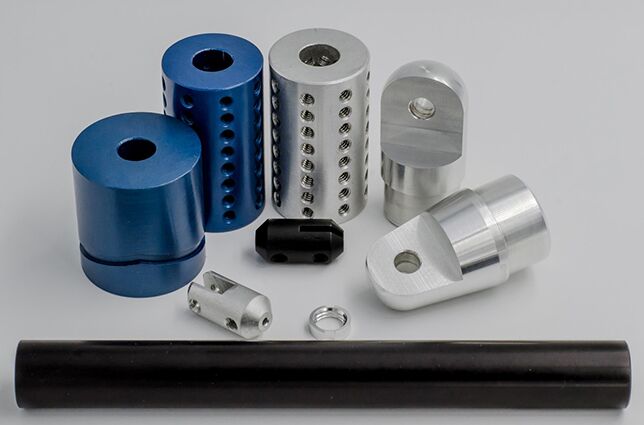Why Anodize Precision Machined Components?
Anodizing precision machined components provides a reliable and relatively inexpensive means of improving the wear resistance, and coloring aluminum and other nonferrous metals. First developed in the 1920s, this electrochemical process revolutionized numerous industries with a need for lightweight, strong, corrosion-resistant aluminum extrusions for window frames, decorative exterior panels and many other architectural elements.
Today it protects satellites, skyscraper facades and components for a wide variety of industries from aerospace to medical and is one of the most efficient ways to make aluminum parts that last and require little maintenance.
How It Is Done
Anodizing is a form of highly controlled oxidation. In nature, oxidation corrodes ferrous metals. However, applied properly on nonferrous metals, it has the opposite effect. Aluminum is a common choice because it is lightweight and corrosion-resistant, but processes do exist for titanium, magnesium, zinc, and other metals lacking iron.
The prevalent method for anodizing aluminum involves submerging the part in a sulfuric acid bath, which creates microscopic pores (nanopores) on the aluminum surface. An electric current is applied to the medium, and with the addition of a cathode, oxygen ions release from the acid and bind to the aluminum. This forms an oxide layer, and if desired color could be applied at this time. Finally, a sealant is applied to close the nanopores and any micro-fissures in the oxide layer.
Unlike plating or paint, which merely cover the surface, anodization is part of the metal and so will not flake, chip or peel over time. It is like the conversion process of black oxidation for steel alloys which also will not flake or peel because the oxidation is converted from the metal.
Benefits
Durability. As noted above, anodization changes the aluminum substrate on the molecular level. Anodized parts do not chip, peel, or flake, and are incredibly resistant to corrosion and abrasion. If properly sealed, expect a minimum of five years in outdoor conditions.
Low cost, high value. Anodized aluminum parts last much longer than their painted or plated equivalent and cost less to make.
Environmentally safe. Unlike painting and plating, anodizing does not generate hazardous waste or interfere with the recyclability of aluminum.
Easy maintenance. Parts emerge from production looking pristine and stay that way for years. Soap and water or mild cleaners remove grime and restore the finish with relative ease.
Aesthetics. Anodizing precision machined components allows parts to retain their metallic finish, and colors are easily repeatable for future production runs.
Improved lubrication. For internal components, the porous nature of unsealed anodized surfaces improves the bonding of adhesives and lubrication. However, this can expose them to contaminants and unsealed or partially sealed parts require special care and consideration.
Considerations
The positives far outweigh the negatives, but anodizing is not a miraculous solution. The application and environment must be carefully considered for each component before choosing anodizing as a finishing application.
Prolonged exposure to ultraviolet (UV) light can cause dyes to fade over time. More resistant dyes are available, but UV-resistance narrows the field of available colors.
Touch-ups of anodized product are almost impossible to miss. Although anodized surfaces are incredibly resistant to damage, they are not invincible. Paint touch-ups will be noticeable even to the untrained eye.
Compared to paint, color selection is limited. For all of anodizing’s advantages, paint will always provide more color options in exchange for higher cost and lower durability.
Faulty sealing will expose anodized parts to corrosion if you have the misfortune of hiring an under-qualified manufacturer.
Temperatures in excess of 176℉ (80℃) can crack anodized aluminum, which has lower thermal conductivity and coefficient of linear expansion than uncoated aluminum.
Anodizing can change the size of the component, anywhere from .0002” to .002” (5 micros to 50 microns) of thickness. The process increases the dimensions of any surface by half the thickness of the oxide, as half of treatment exists within the surface itself.
Anodizing Services at Oil & Gas Industry Parts China
With over 25 years of experience manufacturing precision parts, we consider anodizing a reliable, economical and proven finishing process for aluminum components. Oil & Gas Industry Parts China uses a network of qualified partners to provide anodizing finishes to our client projects.
Available colors include clear, yellow, green, red, and black.
As an AS9100D and ISO9001:2015 certified supplier, all parts are subject to rigorous inspection and quality assurance, according to the specification required for the project which keeps your anodized parts looking their best for years on-end.
For more information on the other types of Finishing Services that Oil & Gas Industry Parts China provides, here is an overview. To view some of the many components, that Oil & Gas Industry Parts China has precision machined, see our Product Gallery.
For inquiries, please contact our sales and engineering team to discuss your next project. We require a component print for review. Some of the considerations for providing a quotation will be:
- Metal type
- End use of product
- Alloy, temper, and finish desired
- Anodizing specification/requirement
- Color considerations
- Special packaging and protective treatment
- Production quantities
- Testing and certification requirements



